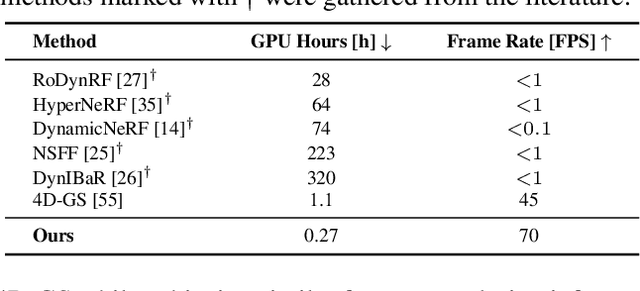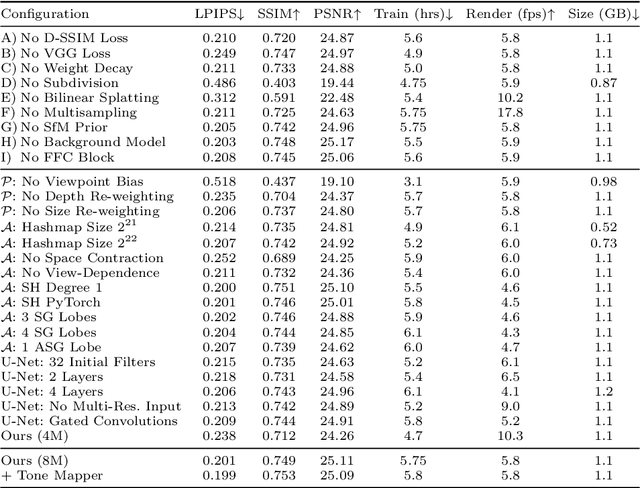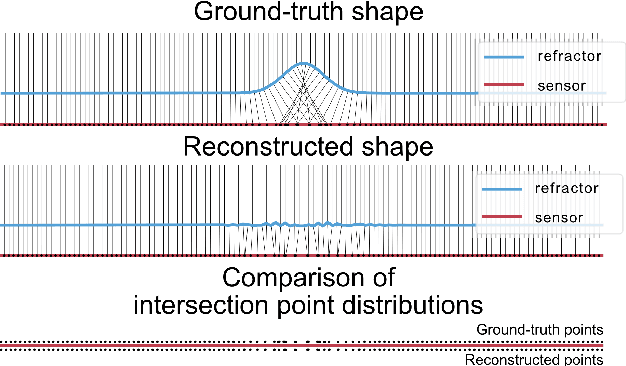Susana Castillo
RadField3D: A Data Generator and Data Format for Deep Learning in Radiation-Protection Dosimetry for Medical Applications
Dec 18, 2024Abstract:In this research work, we present our open-source Geant4-based Monte-Carlo simulation application, called RadField3D, for generating threedimensional radiation field datasets for dosimetry. Accompanying, we introduce a fast, machine-interpretable data format with a Python API for easy integration into neural network research, that we call RadFiled3D. Both developments are intended to be used to research alternative radiation simulation methods using deep learning.
Efficient Perspective-Correct 3D Gaussian Splatting Using Hybrid Transparency
Oct 10, 2024



Abstract:3D Gaussian Splats (3DGS) have proven a versatile rendering primitive, both for inverse rendering as well as real-time exploration of scenes. In these applications, coherence across camera frames and multiple views is crucial, be it for robust convergence of a scene reconstruction or for artifact-free fly-throughs. Recent work started mitigating artifacts that break multi-view coherence, including popping artifacts due to inconsistent transparency sorting and perspective-correct outlines of (2D) splats. At the same time, real-time requirements forced such implementations to accept compromises in how transparency of large assemblies of 3D Gaussians is resolved, in turn breaking coherence in other ways. In our work, we aim at achieving maximum coherence, by rendering fully perspective-correct 3D Gaussians while using a high-quality approximation of accurate blending, hybrid transparency, on a per-pixel level, in order to retain real-time frame rates. Our fast and perspectively accurate approach for evaluation of 3D Gaussians does not require matrix inversions, thereby ensuring numerical stability and eliminating the need for special handling of degenerate splats, and the hybrid transparency formulation for blending maintains similar quality as fully resolved per-pixel transparencies at a fraction of the rendering costs. We further show that each of these two components can be independently integrated into Gaussian splatting systems. In combination, they achieve up to 2$\times$ higher frame rates, 2$\times$ faster optimization, and equal or better image quality with fewer rendering artifacts compared to traditional 3DGS on common benchmarks.
D-NPC: Dynamic Neural Point Clouds for Non-Rigid View Synthesis from Monocular Video
Jun 14, 2024



Abstract:Dynamic reconstruction and spatiotemporal novel-view synthesis of non-rigidly deforming scenes recently gained increased attention. While existing work achieves impressive quality and performance on multi-view or teleporting camera setups, most methods fail to efficiently and faithfully recover motion and appearance from casual monocular captures. This paper contributes to the field by introducing a new method for dynamic novel view synthesis from monocular video, such as casual smartphone captures. Our approach represents the scene as a $\textit{dynamic neural point cloud}$, an implicit time-conditioned point distribution that encodes local geometry and appearance in separate hash-encoded neural feature grids for static and dynamic regions. By sampling a discrete point cloud from our model, we can efficiently render high-quality novel views using a fast differentiable rasterizer and neural rendering network. Similar to recent work, we leverage advances in neural scene analysis by incorporating data-driven priors like monocular depth estimation and object segmentation to resolve motion and depth ambiguities originating from the monocular captures. In addition to guiding the optimization process, we show that these priors can be exploited to explicitly initialize our scene representation to drastically improve optimization speed and final image quality. As evidenced by our experimental evaluation, our dynamic point cloud model not only enables fast optimization and real-time frame rates for interactive applications, but also achieves competitive image quality on monocular benchmark sequences. Our project page is available at https://moritzkappel.github.io/projects/dnpc.
INPC: Implicit Neural Point Clouds for Radiance Field Rendering
Mar 25, 2024



Abstract:We introduce a new approach for reconstruction and novel-view synthesis of unbounded real-world scenes. In contrast to previous methods using either volumetric fields, grid-based models, or discrete point cloud proxies, we propose a hybrid scene representation, which implicitly encodes a point cloud in a continuous octree-based probability field and a multi-resolution hash grid. In doing so, we combine the benefits of both worlds by retaining favorable behavior during optimization: Our novel implicit point cloud representation and differentiable bilinear rasterizer enable fast rendering while preserving fine geometric detail without depending on initial priors like structure-from-motion point clouds. Our method achieves state-of-the-art image quality on several common benchmark datasets. Furthermore, we achieve fast inference at interactive frame rates, and can extract explicit point clouds to further enhance performance.
Fast Non-Rigid Radiance Fields from Monocularized Data
Dec 02, 2022



Abstract:3D reconstruction and novel view synthesis of dynamic scenes from collections of single views recently gained increased attention. Existing work shows impressive results for synthetic setups and forward-facing real-world data, but is severely limited in the training speed and angular range for generating novel views. This paper addresses these limitations and proposes a new method for full 360{\deg} novel view synthesis of non-rigidly deforming scenes. At the core of our method are: 1) An efficient deformation module that decouples the processing of spatial and temporal information for acceleration at training and inference time; and 2) A static module representing the canonical scene as a fast hash-encoded neural radiance field. We evaluate the proposed approach on the established synthetic D-NeRF benchmark, that enables efficient reconstruction from a single monocular view per time-frame randomly sampled from a full hemisphere. We refer to this form of inputs as monocularized data. To prove its practicality for real-world scenarios, we recorded twelve challenging sequences with human actors by sampling single frames from a synchronized multi-view rig. In both cases, our method is trained significantly faster than previous methods (minutes instead of days) while achieving higher visual accuracy for generated novel views. Our source code and data is available at our project page https://graphics.tu-bs.de/publications/kappel2022fast.
N-SfC: Robust and Fast Shape Estimation from Caustic Images
Dec 13, 2021



Abstract:This paper deals with the highly challenging problem of reconstructing the shape of a refracting object from a single image of its resulting caustic. Due to the ubiquity of transparent refracting objects in everyday life, reconstruction of their shape entails a multitude of practical applications. The recent Shape from Caustics (SfC) method casts the problem as the inverse of a light propagation simulation for synthesis of the caustic image, that can be solved by a differentiable renderer. However, the inherent complexity of light transport through refracting surfaces currently limits the practicability with respect to reconstruction speed and robustness. To address these issues, we introduce Neural-Shape from Caustics (N-SfC), a learning-based extension that incorporates two components into the reconstruction pipeline: a denoising module, which alleviates the computational cost of the light transport simulation, and an optimization process based on learned gradient descent, which enables better convergence using fewer iterations. Extensive experiments demonstrate the effectiveness of our neural extensions in the scenario of quality control in 3D glass printing, where we significantly outperform the current state-of-the-art in terms of computational speed and final surface error.
High-Fidelity Neural Human Motion Transfer from Monocular Video
Dec 20, 2020



Abstract:Video-based human motion transfer creates video animations of humans following a source motion. Current methods show remarkable results for tightly-clad subjects. However, the lack of temporally consistent handling of plausible clothing dynamics, including fine and high-frequency details, significantly limits the attainable visual quality. We address these limitations for the first time in the literature and present a new framework which performs high-fidelity and temporally-consistent human motion transfer with natural pose-dependent non-rigid deformations, for several types of loose garments. In contrast to the previous techniques, we perform image generation in three subsequent stages, synthesizing human shape, structure, and appearance. Given a monocular RGB video of an actor, we train a stack of recurrent deep neural networks that generate these intermediate representations from 2D poses and their temporal derivatives. Splitting the difficult motion transfer problem into subtasks that are aware of the temporal motion context helps us to synthesize results with plausible dynamics and pose-dependent detail. It also allows artistic control of results by manipulation of individual framework stages. In the experimental results, we significantly outperform the state-of-the-art in terms of video realism. Our code and data will be made publicly available.
 Add to Chrome
Add to Chrome Add to Firefox
Add to Firefox Add to Edge
Add to Edge